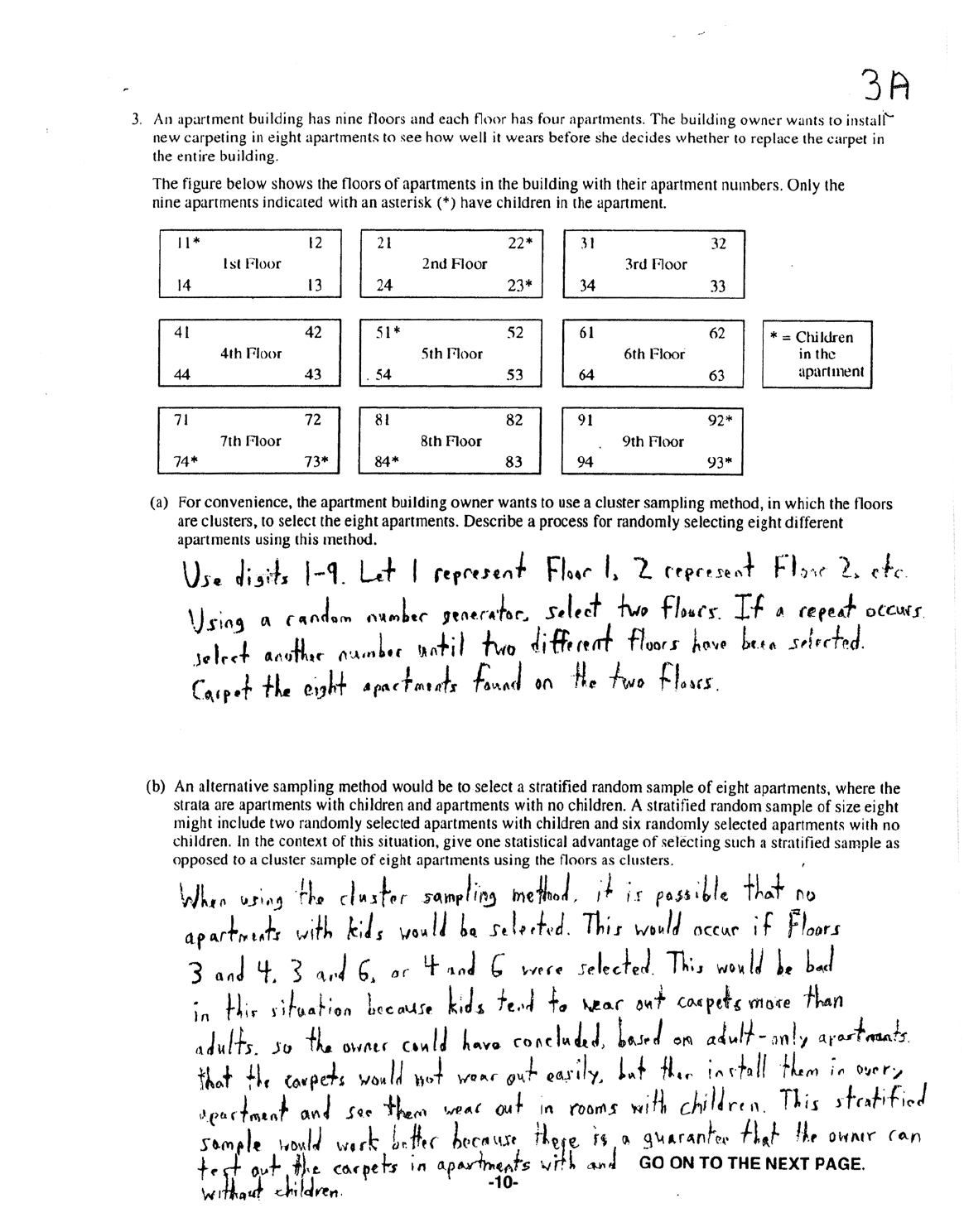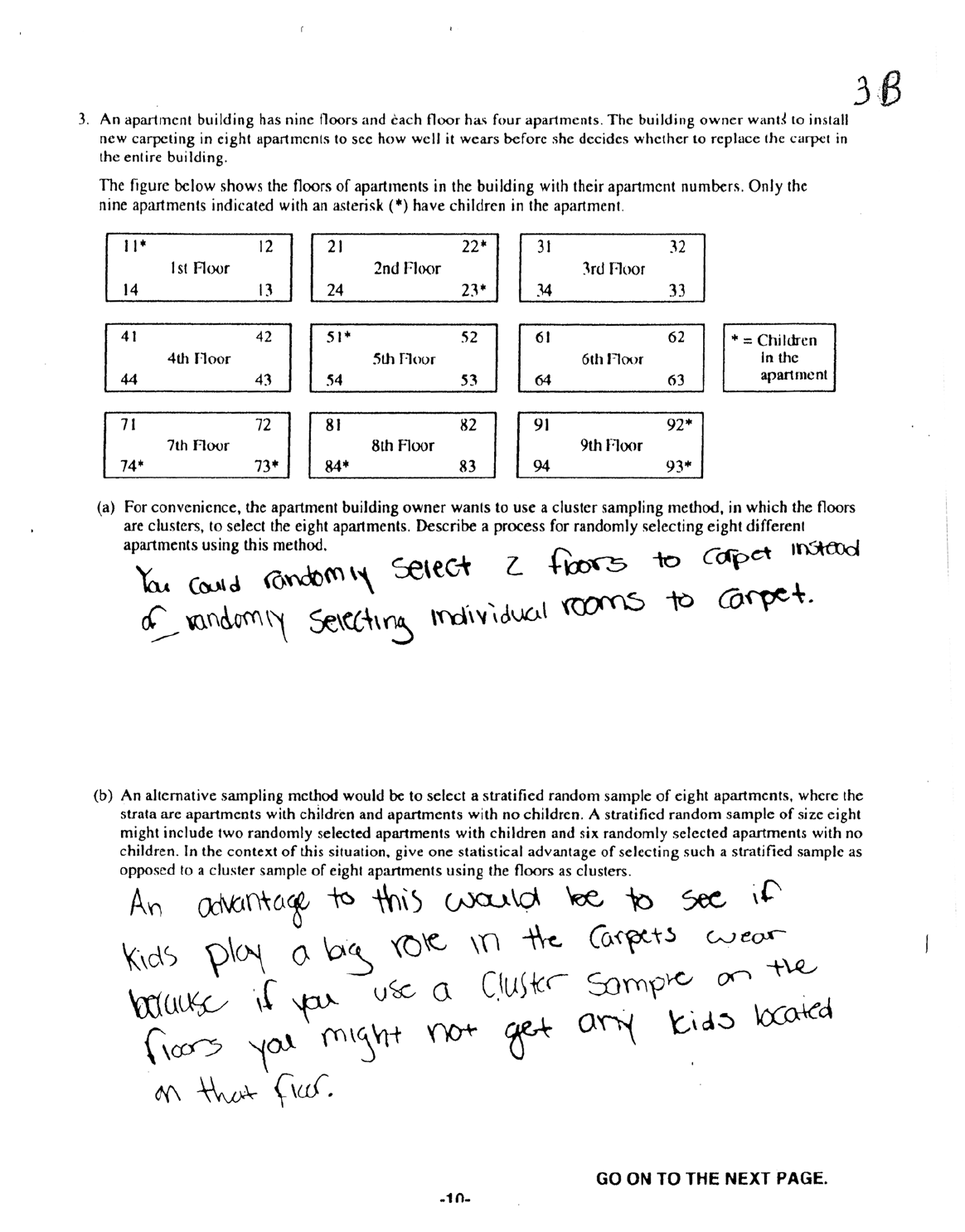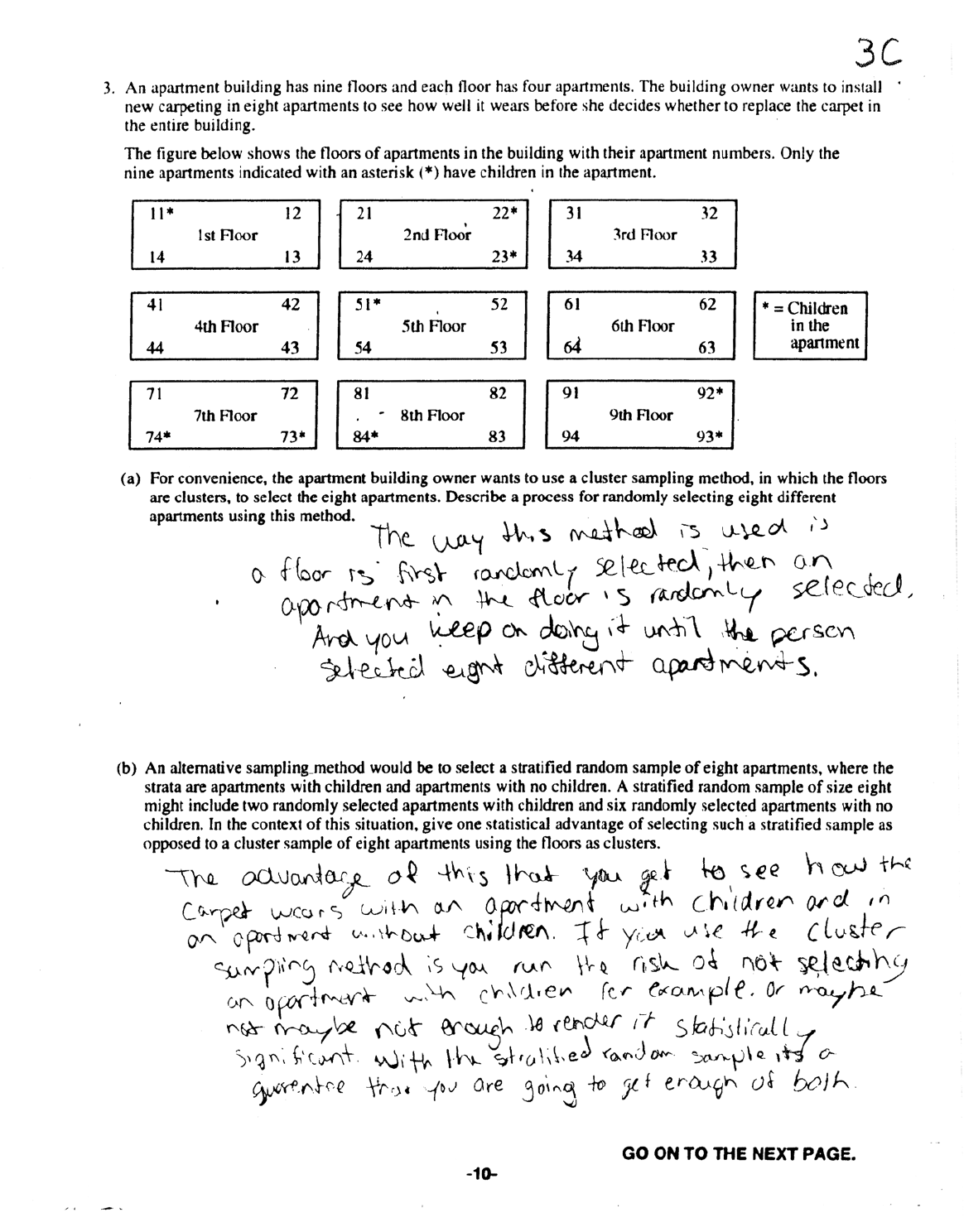
AP
®
STATISTICS
2011 SCORING GUIDELINES
© 2011 The College Board.
Visit the College Board on the Web: www.collegeboard.org.
Question 3
Intent of Question
The primary goals of this question were to assess students’ ability to (1) describe a process for
implementing cluster sampling; (2) describe a statistical advantage of stratified sampling over cluster
sampling in a particular situation.
Solution
Part (a):
The following two-step process can be used to select the eight apartments.
Step 1: Generate a random integer between 1 and 9, inclusive, using a calculator, a computer program,
or a table o
f random digits. Select all four apartments on the floor corresponding to the selected
integer.
Step 2: Generate another random integer between 1 and 9, inclusive. If the generated integer is the
same as the integer gene
rated in step 1, continue generating random integers between 1 and 9
until a different integer appears. Again select all four apartments on the floor corresponding to
the second selected integer.
The cluster sample consists of the eight apartments on the two randomly selected floors.
Part (b):
Because the amount of wear on the carpets in apartments with children could be different from the
wear on the carpets in ap
artments without children, it would be advantageous to have apartments
with children represented in the sample. The cluster sampling procedure in part (a) could produce a
sample with no children in the selected apartments; for example, a cluster sample of the apartments on
the third and sixth floors would consist entirely of apartments with no children. Stratified random
sampling, where the two strata are apartments with children and apartments without children,
guarantees a sample that includes apartments with and without children, which, in turn, would yield
sample data that are representative of both types of apartments.
Scoring
Parts (a) and (b) are scored as essentially correct (E), partially correct (P) or incorrect (I).
Part (a) is scored as follows:
Essentially correct (E) if the response correctly addresses the following two components:
1. Indication that two floors are randomly
selected, with all four apartments on each of the
selected floors forming the sample (or that the entire floors should be carpeted).
2. Description of a valid r
andom sampling procedure for selecting two floors that could be
implemented after reading the response (so that two knowledgeable statistics users would use
the same method to select the floors).
Partially correct (P) if the response includes exactly one of the two components listed above.
AP
®
STATISTICS
2011 SCORING GUIDELINES
© 2011 The College Board.
Visit the College Board on the Web: www.collegeboard.org.
Question 3 (continued)
Incorrect (I) if the response includes neither of the two components listed above OR the response does
not involve t
aking a random sample of two floors out of the nine.
Note: Some possible errors in component 2 include the following:
• Using 10 random digits rather than nine
• Failing to explicitly deal with the issue of potentially repeated random numbers
Part (b) is scored as follows:
Essentially correct (E) if the response indicates the following two components:
1. The amount of carpet wear could be different for apartments with and without children.
2. The stratified random sample ensures that some apartments with children will be selected.
Partially correct (P) if the response includes exactly one of the two components listed above.
Incorrect (I) if the response fails to meet the criteria for E or P.
Notes
• If the response in part (b) says that this stratified sampling method guarantees proportional
representation of a
partments with and without children, then the second component is satisfied.
• If the sampling procedure in part (a) divides the floors into two groups — those that have
apartments with children and those that do not
(“prestratification”) — and then selects one floor
from each group, score part (b) based on the degree to which a statistical advantage of the
stratified sampling in part (b) is addressed.
4 Complete Response
Both parts essentially cor
rect
3 Substantial Response
One part essentially correct and one part partial
ly correct
2 Developing Response
One part essentially correct and one part incorrect
OR
Two parts partially correct
1 Minimal Response
One part par
tially correct and one
part incorrect

© 2011 The College Board.
Visit the College Board on the Web: www.collegeboard.org.

© 2011 The College Board.
Visit the College Board on the Web: www.collegeboard.org.

© 2011 The College Board.
Visit the College Board on the Web: www.collegeboard.org.
AP
®
STATISTICS
2011 SCORING COMMENTARY
Question 3
Overview
The primary goals
of this question were to assess students’ ability to (1) describe a process for
implementing cluster sampling; (2) describe a statistical advantage of stratified sampling over cluster
sampling in a particular situation.
Sample: 3A
Score:
4
In part (a) the st
udent assigns each floor a unique number, 1–9, and correctly describes the use of a
random number generator to select two floors, including what to do in the case of repeated random
numbers. The student then indicates that all eight apartments on the selected floors will be carpeted.
Part (a) was scored as essentially correct. In part (b) the student begins by stating that for cluster
sampling “it is possible that no apartments with kids would be selected,” and gives the combinations of
two floors for which this statement is true. The student argues that this is “bad … because kids tend to
wear out carpets more than adults,” and provides a consequence of such a sample for the owner. The
student then states that a “stratified sample would work better” because the sample will contain
“apartments with and without children.” The strong response in this part was scored as essentially
correct. Because both parts were scored as essentially correct, the response earned a score of 4.
Sample: 3B
Score:
3
In part (a) the st
udent suggests that one “could randomly select 2 floors to carpet.” Although this does
not explicitly state that eight apartments are to be carpeted, the idea of carpeting entire floors is
sufficient to indicate that four apartments on each floor will be carpeted. However, the student makes
no attempt to implement a valid random sampling procedure for selecting the two floors. Part (a) was
scored as partially correct. In part (b) the student indicates that the “advantage to this [the stratified
sample] would be to see if kids play a big role in the carpets [sic] wear,” as opposed to the cluster
sample in which “you might not get any kids.” The communication is weak, but the student does
address the difference in carpet wear between the apartments with and without children and also
indicates that a cluster sample might not include apartments with children. Part (b) was scored as
essentially correct. Because one part was scored as essentially correct and one part was scored as
partially correct, the response earned a score of 3.
Sample: 3C
Score:
2
In part (a) the student describes a non-cluster sample and does not describe a random sample of two
fl
oors from the nine. Part (a) was scored as incorrect. In part (b) the student indicates in the first two
sentences that a stratified sample will have apartments with and without children (as opposed to the
cluster sampling method) and that “you get to see how the carpet wears” in both types of apartments.
This is sufficient to answer the question; the remaining sentences were considered extraneous and did
not detract from the response. Part (b) was scored as essentially correct. Because one part was scored as
essentially correct and one part was scored as incorrect, the response earned a score of 2.
© 2011 The College Board.
Visit the College Board on the Web: www.collegeboard.org.
